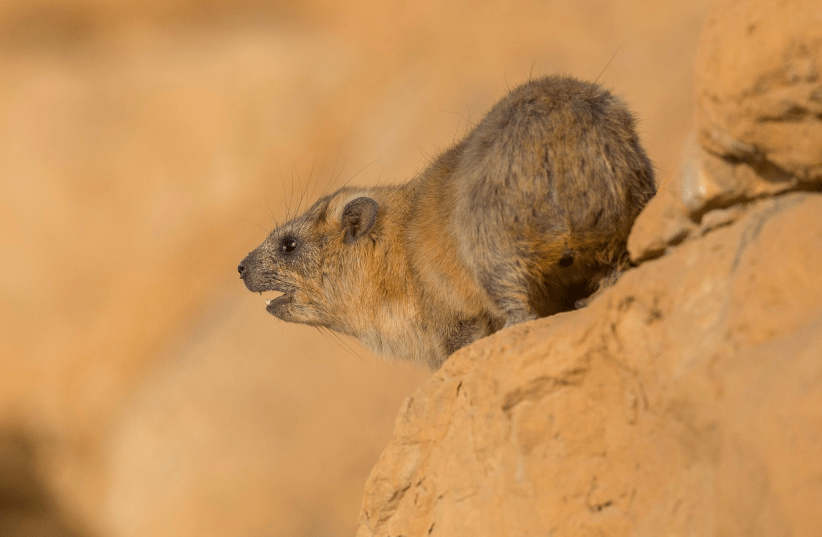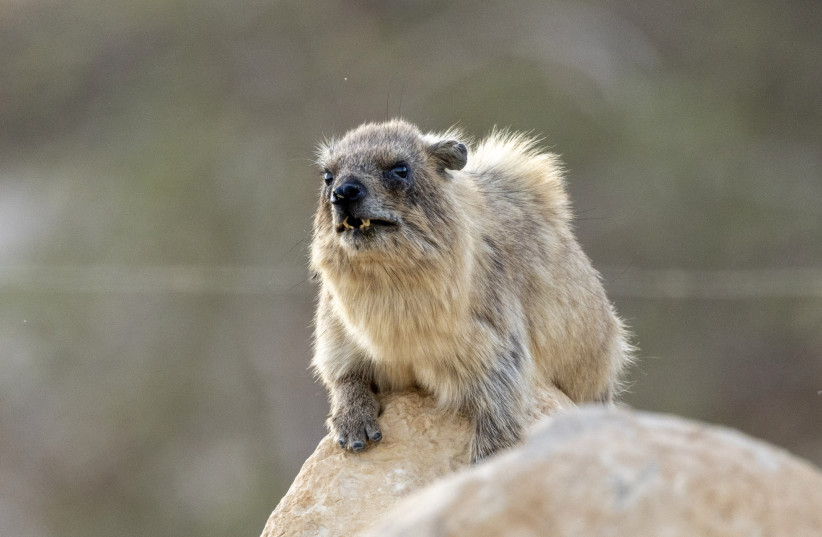Hyraxes are medium-sized, plant-eating mammals with soft, gray-brown or yellowish fur that look like a robust, oversized guinea pig or a rabbit with rounded ears and no tail. Native to Africa and the Middle East, the species are common on hills in Israel and have some unpleasant characteristics.
They bite, can spread rabies and, when bitten by sandflies, can transmit a parasite, causing a disease characterized by irregular bouts of fever, weight loss, enlargement of the spleen and liver and anemia that could be fatal if left untreated.
Their redeeming feature is that the males sing beautiful courting songs to female hyraxes. A new study on animal behavior that involved researchers from Bar-Ilan University (BIU) in Ramat Gan has linked reproductive success in male rock hyraxes to their ability to maintain rhythm during songs.
“Male hyraxes that sing more frequently tend to have more surviving offspring,” said Prof. Lee Koren, of BIU’s Goodman Faculty of Life Sciences, who initiated the study with Dr. Eli Geffen.
It has just been published in the British Ecological Society’s Journal of Animal Ecology under the title “Male rock hyraxes that maintain an isochronous song rhythm achieve higher reproductive success.”
One only needs to look at the adoring fans of famous musicians, such as the Beatles and the Red Hot Chili Peppers, to realize that being rhythmically skilled is a desirable trait. In male rock hyraxes, singing frequency and rhythm (nonrandom temporal structure) could be seen as indicators of individual quality by potential mates, signaling information about their health and suitability as a partner.
How was the research conducted?
To investigate the role of rhythm in mammalian courtship songs, the scientists observed the daily morning activity of hyrax communities between 2002 and 2013 at the Ein Gedi Nature Reserve near the Dead Sea. The researchers captured information about the hyraxes’ location, behaviors and vocalizations while recording the identities of their nearest neighbors. Genetic information for each hyrax was then analyzed in the lab alongside audio recordings.
“Male hyraxes that sing more frequently tend to have more surviving offspring. Song rhythms and stability are related to reproductive success and thus potentially hold information about individual quality.”
Prof. Lee Koren
“Male hyraxes that sing more frequently tend to have more surviving offspring,” Koren said. “Song rhythms and stability are related to reproductive success and thus potentially hold information about individual quality.”
Unlike many other animals known to communicate through song, hyraxes usually sing alone, according to Dr. Vlad Demartsev, who collected the data for this study while at Tel Aviv University and is now a postdoctoral researcher in the biology department at the University of Konstanz and the Max Planck Institute of Animal Behavior.
“Their songs have regional dialects, so individuals living in proximity sing more similarly to each other,” he said. “They tend to sing in crescendo [getting louder as the song progresses] and reach peak complexity towards the end of their songs, maybe to keep the audience engaged and listening to the signals.”
“We have been studying hyraxes for the past 20 years and have previously found several patterns in their songs that are common features of human language and music,” he added.
Rhythm in the nature
Rhythm plays a crucial role in the communication of some animals. Acoustic courtship displays have been described in fish, insects, frogs and mammals. Nevertheless, bird songs remain the most widespread and best-described examples, with signal diversity, rate, complexity and consistency shown to be attractive to the opposite sex.
Compared to bird songs, mammalian vocal displays are usually less elaborate. Nevertheless, several mammalian species produce acoustic displays that can be defined as songs due to their syntactic and structural complexity. One assumption is that rhythm has evolved so that animals that call in groups can better synchronize their songs, for example, musicians in a band or singers in a choir.
Hyraxes have an eight-month-long gestation period, with the pups being born in March and April. A female will usually give birth to one to four pups, and the group engages in limited communal care, such as babysitting and predator defense. Despite this, on average, only 10% of the pups survive the first year, whereas the juvenile and adult survival rate is less than 75%.
Since certain physiological ailments may have a negative effect on the ability of hyraxes to produce precise, rhythmic calls, the researchers suggest male hyrax courtship song rhythm could be an indicator of health and suitability as mates to prospective female partners.
Rhythm has now been shown to act as an advertisement for individual quality in some species, while in others, it helps in coordinating signals from different individuals within a group. However, the researchers said it is not yet known if different rhythmic patterns are used for these two different functions.

